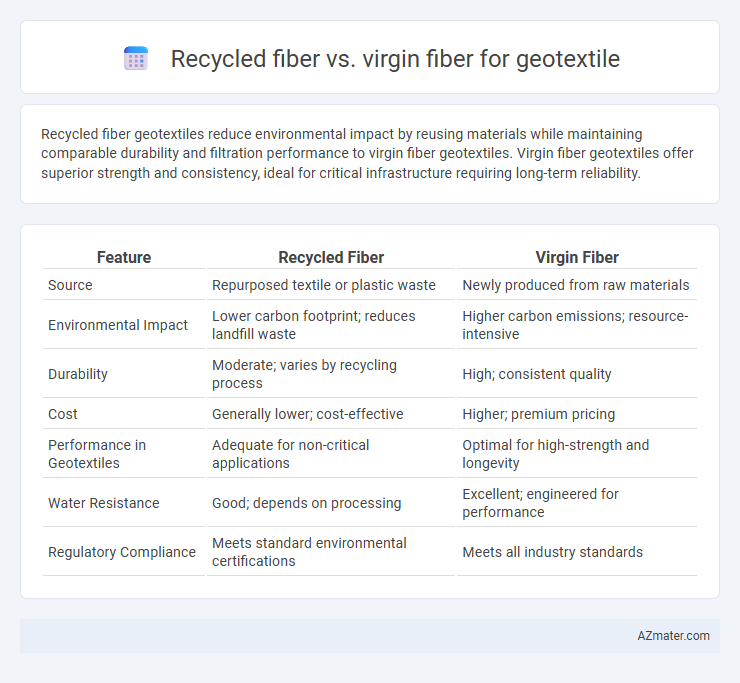Recycled fiber geotextiles reduce environmental impact by reusing materials while maintaining comparable durability and filtration performance to virgin fiber geotextiles. Virgin fiber geotextiles offer superior strength and consistency, ideal for critical infrastructure requiring long-term reliability.
Table of Comparison
| Feature | Recycled Fiber | Virgin Fiber |
|---|---|---|
| Source | Repurposed textile or plastic waste | Newly produced from raw materials |
| Environmental Impact | Lower carbon footprint; reduces landfill waste | Higher carbon emissions; resource-intensive |
| Durability | Moderate; varies by recycling process | High; consistent quality |
| Cost | Generally lower; cost-effective | Higher; premium pricing |
| Performance in Geotextiles | Adequate for non-critical applications | Optimal for high-strength and longevity |
| Water Resistance | Good; depends on processing | Excellent; engineered for performance |
| Regulatory Compliance | Meets standard environmental certifications | Meets all industry standards |
Introduction to Geotextiles
Geotextiles are permeable fabrics used in civil engineering to improve soil stability, erosion control, and drainage. Recycled fiber geotextiles offer sustainable benefits by reducing waste and lowering environmental impact compared to virgin fiber products, which are made from raw materials and often provide superior strength and durability. Selecting between recycled and virgin fiber depends on project requirements, balancing environmental goals with structural performance needs.
Overview of Recycled Fiber
Recycled fiber in geotextile production primarily comes from post-consumer and post-industrial polyester or polypropylene waste, offering an eco-friendly alternative to virgin fibers by reducing landfill waste and conserving natural resources. These fibers maintain adequate tensile strength and durability for various civil engineering applications, including erosion control and soil stabilization, while significantly lowering carbon emissions during manufacturing. The growing adoption of recycled fibers in geotextiles contributes to sustainable construction practices without compromising performance standards.
Overview of Virgin Fiber
Virgin fiber used in geotextiles is derived from natural sources like polypropylene or polyester, ensuring optimal strength, durability, and consistent quality. This fiber offers superior resistance to UV degradation, chemical exposure, and mechanical stress, making it ideal for long-term geotechnical applications. Compared to recycled fibers, virgin fibers provide enhanced filtration, separation, and reinforcement performance in soil stabilization projects.
Manufacturing Processes: Recycled vs Virgin Fiber
Manufacturing processes for geotextiles using recycled fiber involve shredding, cleaning, and reprocessing post-consumer or post-industrial waste, which significantly reduces energy consumption and raw material extraction compared to virgin fiber production. Virgin fiber manufacturing starts with harvesting natural fibers or producing synthetic polymers, followed by extrusion or spinning, requiring higher energy inputs and producing more emissions. The recycled fiber approach promotes sustainability by minimizing landfill waste and conserving natural resources while maintaining comparable performance in geotextile applications.
Mechanical Properties Comparison
Recycled fiber geotextiles often exhibit lower tensile strength and elongation compared to virgin fiber counterparts due to variations in fiber integrity and processing methods. Virgin fiber geotextiles provide superior mechanical performance, including higher puncture resistance and consistent elongation, making them ideal for demanding civil engineering applications. However, advances in recycling technology are narrowing the mechanical performance gap, enhancing recycled fiber durability and load-bearing capacity in geotextile products.
Environmental Impact Assessment
Recycled fiber geotextiles significantly reduce environmental impact by minimizing resource extraction and lowering carbon emissions compared to virgin fiber alternatives. Life cycle assessments reveal that recycled fibers consume less energy and water, contributing to decreased landfill waste and reduced ecological footprint. Selecting recycled fibers promotes sustainable construction practices and supports circular economy principles in geotechnical applications.
Cost Analysis: Recycled vs Virgin Fiber
Recycled fiber geotextiles typically offer a 30-50% cost reduction compared to virgin fiber alternatives due to lower raw material expenses and energy consumption during production. Although recycled fibers may have slightly lower tensile strength and durability, their cost-effectiveness makes them ideal for non-critical civil engineering applications. Lifecycle analysis indicates reduced environmental impact, enhancing overall value despite modest performance trade-offs against virgin fiber geotextiles.
Performance in Geotechnical Applications
Recycled fiber geotextiles often exhibit comparable tensile strength and durability to virgin fiber alternatives, making them suitable for various geotechnical applications such as soil stabilization and erosion control. Virgin fibers typically offer more consistent performance, especially in extreme environmental conditions, due to their higher purity and controlled manufacturing processes. Long-term filtration efficiency and resistance to chemical degradation are critical factors where virgin fibers generally outperform recycled options, ensuring greater reliability in demanding infrastructure projects.
Durability and Lifespan Considerations
Recycled fiber geotextiles often exhibit reduced durability compared to virgin fiber options due to potential contamination and shorter polymer chains, which can compromise mechanical strength and UV resistance. Virgin fiber geotextiles typically offer enhanced lifespan and consistent performance under harsh environmental conditions, making them preferable for long-term applications like erosion control and subgrade stabilization. Lifespan considerations must balance cost savings of recycled fibers against the critical durability requirements of infrastructure projects.
Future Trends in Geotextile Fiber Selection
Emerging trends in geotextile fiber selection emphasize increased use of recycled fibers due to their environmental benefits and cost-effectiveness compared to virgin fibers. Advances in recycling technology improve the durability and performance of recycled fibers, making them competitive alternatives for infrastructure projects demanding high-strength and long-lasting materials. Industry forecasts indicate a growing preference for sustainable geotextiles driven by regulatory pressures and the global push toward circular economy practices.

Infographic: Recycled fiber vs Virgin fiber for Geotextile
 azmater.com
azmater.com